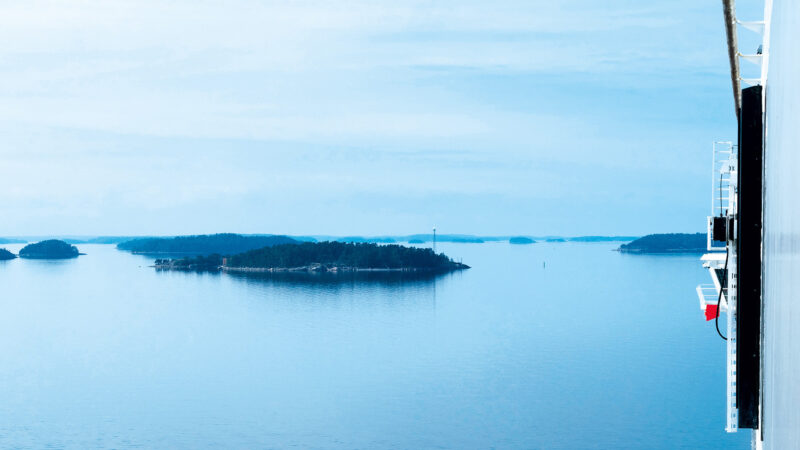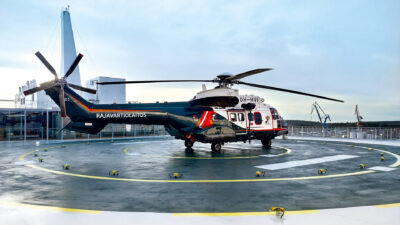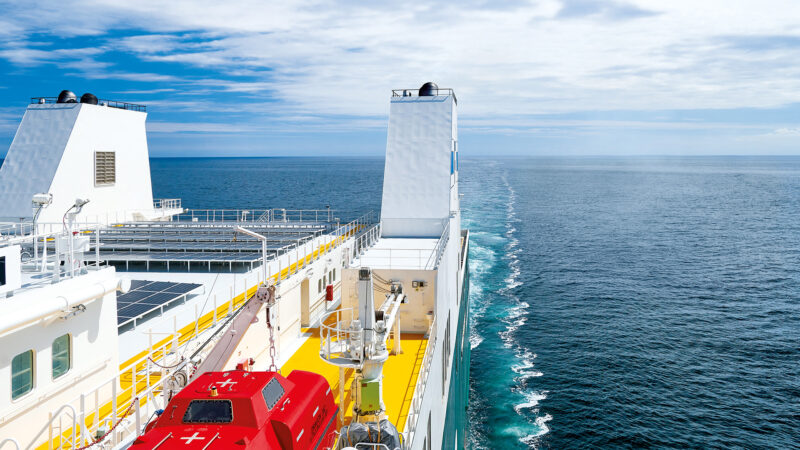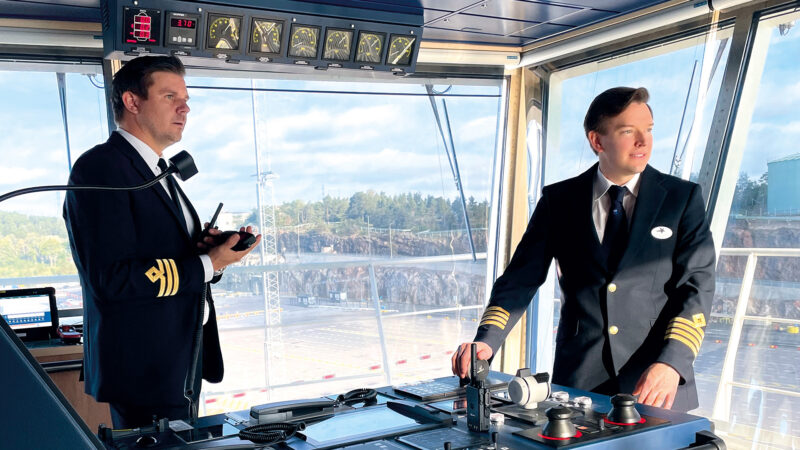Environment and safety
Environmental aspects have a pivotal role in Finnlines’ operations. We produce safe and first-class services in a manner that aims to minimize environmental effects.

Shipping, which transports around 90 per cent of global trade, provides the principal mode of transport for the supply of raw materials, consumer goods, essential foodstuffs and energy to the global population. The vast majority of these products could not be transported any other way than by ship. The Covid-19 pandemic demonstrated the essential role played by transport and the social, health and economic costs when free movement of people, goods and services was severely constrained. Finnlines has an essential role in securing Finland’s security of supply and providing connections to Europe.
Green transition
In summer 2023 the IMO revised its greenhouse gas strategy and raised the ambition level to reach net-zero GHG emissions from international shipping around 2050. The target also includes the commitment to ensure an uptake of alternative zero or near-zero GHG fuels by 2030. CO2 emissions per transport work should decrease by 40 per cent by 2030. All target figures are compared with the 2008 level. The target is now aligned with the European Commission’s target for Europe to become a climate-neutral continent by 2050.
Both globally and within the European Union, numerous proposals are being discussed and already finalized to combat the climate change. To reach the ambitious goals, the shipping sector will have to make the transition to alternative fuels and adopt new technologies.
The EU Commission has adopted a “Fit for 55” package where some of the items are maritime related.
- The Commission has decided to include maritime transport in the emissions trading system (ETS), which has covered energy-intensive industries and flights within EU for nearly two decades. The system covers CO2 emissions from ships of at least 5,000 GT trading in EU. Unlike other industries, the shipping industry does not receive any so called free allowances but has a phase-in period which covers 40 per cent of the annual emissions in 2024, 70 per cent of the emissions in 2025 and from 2026 onwards all emissions within the scope. Ice-strengthened vessels may deduct 5 per cent of their CO2 emissions as they consume more fuel than other vessels due to their structure. Finnlines’ ro-pax vessels providing services between Åland Islands and Finnish mainland may deduct the emissions from these voyages due to so called island exemption.
- The FuelEU Maritime regulation was finalized in the autumn 2023. It will set a maximum limit on the greenhouse gas intensity of energy used by ships. From 2025 the GHG intensity of the fuel used onboard should be reduced by 2 per cent. After that the GHG intensity reduction requirement will increase gradually every five years. Consequently the shipping companies are obligated to start using gradually increasing volumes of alternative fuels onboard ships. From 2030 onwards, passenger ships and container ships will be required to use onshore power supply at berth unless they can demonstrate the use of an alternative zero-emission technology.
- The revision of Energy Taxation Directive aims to promote clean technologies and discourage the use of fossil fuels. The discussion to introduce taxes on fuels over a 10-year transitional period is still ongoing in the EU institutions.
The IMO, in line with the 2023 GHG strategy, is developing mid-term measures for delivering the reduction targets. The basket of candidate measures comprises of:
- a technical element of a fuels standard regulating the reduction of marine fuel’s GHG intensity
- an economic element establishing a GHG emissions pricing mechanism
After impact assessments of the candidate measures and legislative process, the chosen measures are planned to be approved in 2026.
Meeting the targets set by the IMO and the EU and complying with the regulations requires shipping companies to continue improving the ships’ energy efficiency and to start adopting alternative fuels. Certain alternative fuels, like biofuels may be used without any modifications, but most of the future fuels require technical modifications in the existing vessels. The challenge is not only technical readiness but also availability of alternative fuels and in some parts regulatory readiness especially in safety matters.
CO2 emissions
Over the years, Finnlines has invested systematically in improving its fleet’s energy efficiency. The development still continues along with the daily work. In the older fleet, various energy saving technologies have been installed and new options are being studied. The newest vessels have been built utilizing the most modern technologies. For example main engines with low specific fuel consumption have been chosen and high-powered battery banks and air lubrication systems have been installed. Ro-ro vessels have solar panels and ro-pax vessels can use onshore power. Installation of shore-side connections on a few existing ro-pax vessels is also being prepared. Electricity is the first alternative fuel replacing fossil fuels in the Finnlines fleet. Moreover, gradual transition to other zero-carbon and renewable fuels is being investigated.
In addition to technological means, energy efficiency may be improved by operational changes. Finnlines has optimised its schedules and routes to achieve the highest possible capacity utilisation, which minimises the CO2 emissions per transported cargo unit. The optimization will further continue in close co-operation with our customers to enable reduced carbon footprint in the whole logistics chain.
All ships have a Ship Energy Efficiency Management Plan, the purpose of which is to identify energy-saving measures and to establish practices to improve energy efficiency.
Shipowners have had to report on ships’ fuel consumption, subsequent CO2 emissions and transport work to the European Commission as from 2018 in accordance with an EU MRV directive. Globally, a similar system, IMO’s Data Collection System, started in 2019. An accredited, impartial verifier validates the data in both systems.
Other environmental aspects
Finnlines co-operates with waste management companies to reuse, recycle or recover waste in an efficient manner and waste is reprocessed into material or recovered as energy. The main waste types generated on board include plastics, bio waste, glass, paper, cardboard, wood, and metal. Hazardous waste is separated and taken to a designated container in the port.
Oily wastewater, ‘bilge water’, is generated in engine rooms. Bilge water is separated in separators and the remaining sludge is always taken ashore. The limit for the oil content of water that may be discharged into the sea is 15 ppm but many of our ships have more efficient separators. Some bilge water is also pumped ashore.
MARPOL contains restrictions concerning black water, i.e.toilet water. Finnlines’ ro-pax vessels land black and grey water to onshore municipal sewage systems. Cargo ships are equipped with sewage treatment plants, which have been certified by the administration. The target is to gradually
reduce and stop discharging also treated waste water into the Baltic Sea. When technically feasible, some of the cargo ships are already delivering their treated waste waters into shore facilities.
Finnlines operates in ecologically sensitive sea areas, mainly in the Emission Control Areas, i.e. the Baltic Sea, the North Sea and the English Channel, where the sulphur content limit for fuel oil has been 0.10 per cent from 2015 in accordance with the MARPOL Convention, whereas globally, the sulphur limit decreased from 3.5 per cent to 0.5 per cent at the beginning of 2020. Finnlines has installed exhaust gas cleaning systems on 24 vessels since 2015.
Ballast water is used to trim and stabilise ships, but it may carry harmful aquatic species and out-compete native species, disrupting fragile marine ecosystems. In accordance with the IMO Ballast Water Management Convention, all Finnlines ships are fitted with treatment equipment and all ballast water is treated accordingly.
Environmental aspects in port operations
Port and stevedoring operations are an important part of overall efficiency and performance of the Group. Finnsteve companies continue to invest in modern equipment and vehicles, which will take the environmental programme to the next level. NOx emissions from new tug masters, which will
replace the old Tier 1 equipment, will reduce by 96 per cent and particles by 97 per cent. New electric vans and minibuses will be emission free.
Finnsteve companies hold a valid ISO 14 001 environmental certificate and an ISO 9001 quality certificate.
In 2023, the fuel consumption of the port operations totalled 1,029,863 litres, which includes the operations in Helsinki, Turku and Naantali, a decrease of nearly 12 per cent compared with the previous year.
Safety and security
The land-based ship management organisation and all the ships are certified in accordance with the International Safety Management Code (ISM). All ships and port facilities also comply with the requirements of the ISPS Code (International Ship and Port Facility Security Code).
Technical progress, such as digitalisation, integration and automation, brings a risk of malicious attacks to ships’ control systems. Shipowners have therefore identified cyber security objectives relevant for the safe operation of the ship.
The ships are regularly inspected and audited by the maritime administration, classification societies and by inhouse auditors. Regular drills are held both internally and with authorities, such as the border guard, police and local city rescue departments.
In ports, stevedoring companies have safety systems, including communication and contingency plans in case of an accident. Ports are equipped to respond to fires and oil and chemical spills.

Legislation
Shipping is highly regulated by the IMO, EU and national legislations. The IMO regulates environmental and safety matters of international shipping via various conventions, codes and resolutions. MARPOL 73/78 Convention regulates prevention of pollution of the marine environment by ships from operational or accidental causes. SOLAS Convention regulates maritime safety and security, including ship construction, life-saving arrangements and navigation. Port operations comply with national and international legislation.
To ensure safe and environmentally sound recycling of ships, the Hong Kong Convention has been ratified within IMO and will enter into force in June 2025. The EU has also adopted aregulation on ship recycling and inventory of hazardous materials, like mercury, cadmium and lead. Hazardous materials experts have identified the presence of hazardous material contained in the equipment and systems onboard. An inventory shall be maintained throughout the operational life of the ship.
Environmental certification
The environmental management system, which complies with the ISO 14001:2015 standard, was audited in the office and onboard ships during 2023 and a new certificate was issued. A surveillance visit was carried out in autumn 2023. Certification covers management and manning of all ships sailing under theFinnlines flag as well as purchasing, newbuildings, and cargo and ship operations.
Stakeholders
In environmental and safety matters, Finnlines’ most important stakeholders are the flag and port state administration, owners, customers, personnel, port operators, classification society and contractors, as well as the inhabitants of harbour and fairway areas.
Finnlines is represented at the technical, safety and environmental committees under the Swedish and Finnish Shipowners’ Associations and co-operates with maritime colleges and research centres.
During 2023 Finnlines has supported various research projects such as MEPTEC (Comparison of maritime emission control technologies by XAMK), IHATEC (Propeller slip stream induced erosion phenomena, project led by the Universities of Braunschweig and Hamburg in cooperation with WK Consult and the BAW) and Alg@line (Realtime algal monitoring project by SYKE) by providing data from the ships for environmental research use. Alg@line project has been ongoing in Finland–Germany route for over 20 years, where Finnlines has provided space on its vessels for research purposes.

